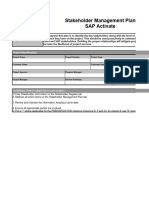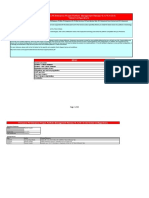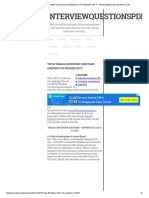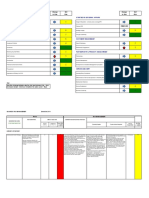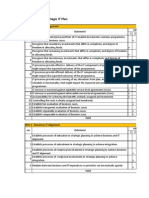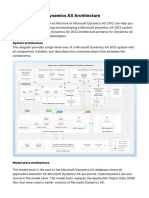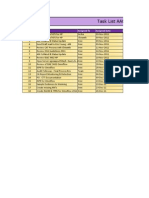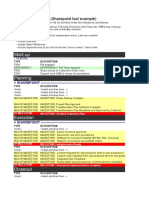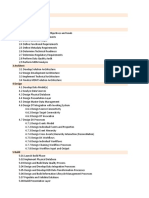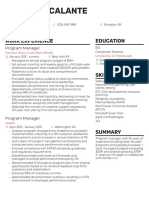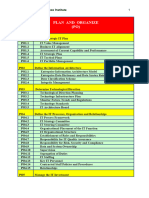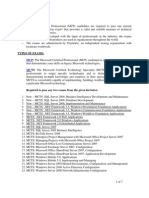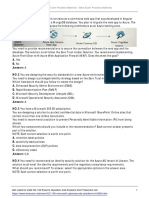0 ratings0% found this document useful (0 votes)
411 viewsTelemetry in MS Office
Telemetry in MS Office
Uploaded by
kashifnooraniTelemetry in MS Office
Copyright:
© All Rights Reserved
Available Formats
Download as PDF, TXT or read online from Scribd
Telemetry in MS Office
Telemetry in MS Office
Uploaded by
kashifnoorani0 ratings0% found this document useful (0 votes)
411 views1 pageTelemetry in MS Office
Copyright
© © All Rights Reserved
Available Formats
PDF, TXT or read online from Scribd
Share this document
Did you find this document useful?
Is this content inappropriate?
Telemetry in MS Office
Copyright:
© All Rights Reserved
Available Formats
Download as PDF, TXT or read online from Scribd
Download as pdf or txt
0 ratings0% found this document useful (0 votes)
411 views1 pageTelemetry in MS Office
Telemetry in MS Office
Uploaded by
kashifnooraniTelemetry in MS Office
Copyright:
© All Rights Reserved
Available Formats
Download as PDF, TXT or read online from Scribd
Download as pdf or txt
You are on page 1of 1
TELEMETRY IN OFFICE 2013
WHAT IS OFFICE TELEMETRY?
A NEW WAY TO ASSESS OFFICE COMPATIBILITY
2012 Microsoft Corporation. All rights reserved. To send feedback about this documentation, please write to us at feedork@microsoft.com.
Office Telemetry is a new compatibility monitoring framework that
works with Office 2013, Office 2010, Office 2007, and Office 2003. This
framework can speed up Office deployments by helping you discover
business-critical Office documents and solutions in your organization.
Office Telemetry in Office 2013 works like this: When an Office
document or solution is loaded, used, closed, or raises an error in certain
Office 2013 applications, the application adds a record about the event
to a local data store. Each record includes a description of the problem
and a link to more information. Inventory and usage data is also tracked.
How does Office Telemetry work in previous versions of Office? Office
Telemetry is new, so its not built into Office 2003, Office 2007, and
Office 2010. For those clients, you deploy an agent that collects
information about installed add-ins and the most recently used
documents. You wont get application event data for these clients, but
you will get inventory and usage data that helps you discover whats in
use and likely important to your business.
You can view this telemetry data using two new tools, Telemetry
Dashboard and Telemetry Log.
Telemetry Dashboard:
Shows IT Pros a consolidated view of inventory
and telemetry data
Requires Excel 2013
Is installed with Office Professional Plus 2013 and
Office 365 ProPlus
Connects to the telemetry database
Can be viewed by multiple IT Pros
Telemetry
Dashboard
Telemetry Log:
Helps developers and experienced users diagnose
compatibility issues on an Office 2013 client
Requires Excel 2013
Is installed with Office Professional Plus 2013 and
Office 365 ProPlus
Connects to the local data store on the client
Telemetry
Log
Shared folder
Telemetry
processor
Telemetry
database
Telemetry agent:
Monitors document and add-in usage for all Office applications in
the 2003, 2007, 2010, and 2013 versions of Office
Is supported on Windows XP and later versions
Must be deployed to Office 2003, Office 2007, and Office 2010
clients
Is built into Office 2013 clients
Must be enabled using Group Policy or the registry
Runs as a scheduled task (except on Windows XP)
Requires domain membership
Periodically uploads data to a shared folder
Shared folder:
Stores telemetry data that is uploaded by telemetry agents
Must be on premises (no cloud support)
Can be located on the same computer as other telemetry
components
Is configured when you install the telemetry processor
Telemetry processor:
Uploads data from the shared folder to the telemetry database
Runs as a Windows service named Office Telemetry Processor
Runs on Windows Server 2008 and later versions
Can be run on Windows 7 and Windows 8 in test or small environments
Can be run on the same computer as other telemetry components
Can be installed on multiple computers for large deployments
Requires domain membership (unless a workaround is used)
Telemetry database:
Provides a data source for Telemetry Dashboard
Requires SQL Server 2005 and later versions
Can be run on SQL Express editions in test or small environments
Can be run on the same computer as other telemetry components
Group Policy settings:
Configure the telemetry agent on each client
Are part of Office15.admx and Office15.adml
Are located under User Configuration\Administrative Templates\
Microsoft Office 2013\Telemetry Dashboard
Telemetry logging:
Monitors events for (and is built into) Word 2013, Excel 2013,
PowerPoint 2013, and Outlook 2013
Is disabled by default
Is enabled by using Group Policy, registry settings, or from within
Telemetry Log
Telemetry
agent
Telemetry
logging
Group Policy
settings
OFFICE TELEMETRY COMPONENTS
WHATS MONITORED IN OFFICE 2013 HOW TELEMETRY DATA IS COLLECTED
Telemetry agents send data
Office 2003 Office 2007 Office 2010
Telemetry agents collect:
Most recently used documents
Registered add-ins
Systemand user information
Telemetry agents collect:
Most recently used documents
Registered add-ins
Systemand user information
For certain applications, the following
information is also collected:
Application events
Add-in performance
64 KB for each upload
50 KB for each upload
0101010101
0101010101
0101010101
0101010101
0101010101
0101010101
Users log in and trigger the
scheduled task that uploads
telemetry data.
The agent waits 10 minutes for
logon processes to complete.
Then, the agent waits for a
randomnumber of minutes, up
to 4 hours, and then begins the
upload process.
After the initial upload, the
agent uploads telemetry data
every 8 hours.
Mobile or offline clients upload
data at logon when the
connection is restored.
Users log in
0***********1
0***********1
0***********1
Document details
can be obfuscated to
protect user privacy.
The number of critical errors that
users hit. Click any number to see
which errors were logged.
The number of seconds it took
for the solution to load.
The rate of Office 2013
sessions that dont have
critical issues.
The number of users who use the
solution. Click any number to see
who uses the solution.
Telemetry
database
Shared folder Telemetry
processor
Data is processed to the database
These components can run on the same computer or on different
computers. You can deploy multiple telemetry processors if needed.
Telemetry processor error logs are in %systemroot%\ServiceProfiles\
NetworkService\AppData\Local\Temp\DPERRORLOG.txt.
Telemetry Dashboard offers three methods that help you protect user
privacy.
Obfuscate
Exclude
Set
threshold
Obfuscate the document name, title, and path
Re********.xlsx
Exclude applications and solution types fromreporting
apps for Office
Application add-ins
COM add-ins
Document files
Template files
Only show files that are used by N or more users
Corporate Scorecard.xlsx Total users: 10
resume.xlsx Total users: 1
If an add-in is causing crashes or takes a long time to load, you can disable the
add-in for all Office 2013 clients. Use the Add-in management worksheet to
generate a Group Policy script that sets the configuration state of add-ins that
are used with Office 2013.
Using the Group Policy administrative templates, you can also create lists of
managed add-ins and optionally block any add-in that isnt on the list. Users
cant override these settings unless you allow themto.
TELEMETRY DASHBOARD
PROTECTING USER PRIVACY MANAGING OFFICE 2013 ADD-INS
1 2
3
Solution Type Applications Description
Active documents Word 2013
PowerPoint 2013
Excel 2013
Active documents are any Office document files
other than the other solution types listed in this
table. This can include the following:
Office binary format files (.doc, .ppt, .pps, .xls).
Office OpenXML format files (.docx, .pptx,
.ppsx, .xlsx).
Macro-enabled files that contain VBA code
(.docm, .dotm, .pptm, .potm, .xlsm, .xltm).
Files that contain ActiveX controls.
Files that have External Data Connections.
COM add-ins Word 2013
PowerPoint 2013
Excel 2013
Outlook 2013
COMadd-ins include Microsoft Office
development tools in Microsoft Visual Studio 2010
application-level add-ins.
Excel Automation
add-ins
Excel 2013 This solution type includes previous versions of
Excel-supported Automation Add-ins, which are
built upon COMadd-ins. Functions in Automation
add-ins can be called from formulas in Excel
worksheets.
Excel XLL add-ins Excel 2013 XLL add-ins (.xll) are specific to Excel and built
with any compiler that supports building DLLs
(dynamic-link libraries). They do not have to be
installed or registered. XLL add-ins also include
DLLs that contain user-defined commands and
functions.
Excel XLS RTD
add-ins
Excel 2013 XLS real-time data (RTD) add-ins are Excel
worksheets that use the RealTimeData worksheet
function to call an Automation server to retrieve
data in real-time.
Word WLL add-ins Word 2013 WLL (.wll) add-ins are specific to Word and built
with any compiler that supports building DLLs.
Application add-ins Application add-ins are application-specific files
that contain VBA code. These include macro-
enabled Word templates (.dotm), Excel add-ins
(.xla, .xlam), and PowerPoint add-ins (.ppa,
.ppam).
Word 2013
PowerPoint 2013
Excel 2013
Templates Templates include document (.dot, .dotx),
worksheet (.xlt, .xltx), or presentation (.pot, .potx)
templates that are attached to an Office file.
Word 2013
PowerPoint 2013
Excel 2013
Task pane
apps for Office
These are apps for Office that are hosted in a task
pane within the client application.
Word 2013
Excel 2013
Project 2013
Content apps for Office These are apps for Office that are integrated into
the content of the Microsoft Office file.
Excel 2013
Mail apps for Office These are apps for Office that appear in when
certain conditions are met (the e-mail body or
subject includes particular words or phrases).
Outlook 2013
Office 2013
IT pros view
consolidated data in
Telemetry Dashboard
4
You might also like
- Week 10 Assignment: Case StudyDocument6 pagesWeek 10 Assignment: Case StudyAnonymous YCIqsWC0% (2)
- Introduction To M365 PresentationDocument50 pagesIntroduction To M365 Presentationlasidoh0% (1)
- PM - 98 - Sample Stakeholder Management PlanDocument16 pagesPM - 98 - Sample Stakeholder Management PlanAlexey MartynovichNo ratings yet
- Eppm 16 1 Tested ConfigsDocument25 pagesEppm 16 1 Tested ConfigsNguyễn Viết HoànNo ratings yet
- XRM WhitepaperDocument10 pagesXRM WhitepaperBhavik PatelNo ratings yet
- Activation KeyDocument13 pagesActivation Keyheryts100% (1)
- ITB Ahmad Dahlan PPT GuidelinesDocument20 pagesITB Ahmad Dahlan PPT GuidelinesFanisa FauziahNo ratings yet
- Individual Performance Commitment and Review Form (Ipcrf) For Teacher I-IiiDocument24 pagesIndividual Performance Commitment and Review Form (Ipcrf) For Teacher I-IiiRutchel MartinezNo ratings yet
- IDG 2016 Cloud Computing SurveyDocument9 pagesIDG 2016 Cloud Computing SurveyIDG_World100% (7)
- Set-2 - InterviewquestionspdfDocument7 pagesSet-2 - InterviewquestionspdfGoliBharggavNo ratings yet
- Ge Itil Six Sigma ItsmDocument12 pagesGe Itil Six Sigma ItsmmzagorskiNo ratings yet
- ITCoree BooksDocument99 pagesITCoree BooksJawad AnwarNo ratings yet
- ITSM 7.6.03 Release NotesDocument22 pagesITSM 7.6.03 Release NotesRam Kumar SundaramNo ratings yet
- Questionnaire BREWERYDocument12 pagesQuestionnaire BREWERYMarinos GiannoukakisNo ratings yet
- Tech Influencer: Technology Buying Trends Related To The NetworkDocument1 pageTech Influencer: Technology Buying Trends Related To The NetworkIDG_WorldNo ratings yet
- P2 Project Management Minimum Requirements Relevant For AssessmentDocument26 pagesP2 Project Management Minimum Requirements Relevant For AssessmentkssandeepNo ratings yet
- Mapping Specifications PowerCenterDocument5 pagesMapping Specifications PowerCenterRom100% (1)
- Director Supply Chain Manufacturing in USA Resume Elena Rodriguez GarciaDocument4 pagesDirector Supply Chain Manufacturing in USA Resume Elena Rodriguez GarciaElenaRodriguezGarciaNo ratings yet
- BOARD1470 Risk RegisterDocument14 pagesBOARD1470 Risk RegisterisolongNo ratings yet
- The Rise of The Developer InfographicDocument1 pageThe Rise of The Developer InfographicIDG_WorldNo ratings yet
- Swot Analysis 3.5: WorksheetDocument62 pagesSwot Analysis 3.5: WorksheetAndroEstreNo ratings yet
- A Guide To Understanding How Organizations Are Evolving To A Digital-First Business ModelDocument1 pageA Guide To Understanding How Organizations Are Evolving To A Digital-First Business ModelIDG_WorldNo ratings yet
- BA Assessment and TrainingDocument9 pagesBA Assessment and TrainingemraheNo ratings yet
- Notes PMP Manoj Parik 20150808Document1 pageNotes PMP Manoj Parik 20150808PrakashNo ratings yet
- IDG Enterprise Cloud Computing Research (2014)Document10 pagesIDG Enterprise Cloud Computing Research (2014)IDG_World100% (1)
- Control Objectives (PO1 - PO2 - PO4)Document22 pagesControl Objectives (PO1 - PO2 - PO4)Rizkie Denny PratamaNo ratings yet
- Cellular ExpertDocument84 pagesCellular ExpertcalhabardoNo ratings yet
- Manager Director Business Excellence in Philadelphia PA Resume Michael WeeksDocument3 pagesManager Director Business Excellence in Philadelphia PA Resume Michael WeeksMichaelWeeksNo ratings yet
- 2017 Global State of Information Security SurveyDocument7 pages2017 Global State of Information Security SurveyIDG_World100% (1)
- XML DITA Authoring Training - TechTotalDocument4 pagesXML DITA Authoring Training - TechTotalTechTotalNo ratings yet
- 2016 Customer Engagement ResearchDocument14 pages2016 Customer Engagement ResearchIDG_World100% (1)
- Abdc Journal ListDocument23 pagesAbdc Journal ListKiran DhankharNo ratings yet
- CBAP DefinitionsDocument11 pagesCBAP DefinitionsMohamed AwadNo ratings yet
- 2021-07-10 - Detail Microsoft Dynamics AX ArchitectureDocument12 pages2021-07-10 - Detail Microsoft Dynamics AX ArchitectureKangeyan DhanapalanNo ratings yet
- E1-VCP Mapping 2011-01-12 AIA 3 1 ReleaseDocument827 pagesE1-VCP Mapping 2011-01-12 AIA 3 1 Releasesamcarte_No ratings yet
- 2020 APP-CSE TemplateDocument316 pages2020 APP-CSE TemplateJanine Jordan Canlas-BacaniNo ratings yet
- The ABCs of ERP - EnterpriseDocument7 pagesThe ABCs of ERP - EnterpriseADIL KAKAKHELNo ratings yet
- ICT Plan of Action For AOsDocument10 pagesICT Plan of Action For AOsSarim 622No ratings yet
- Vendor Reporting TemplateDocument85 pagesVendor Reporting TemplatefalleppaNo ratings yet
- EVP VP Global Operations in San Francisco Bay CA Resume Joel BustosDocument2 pagesEVP VP Global Operations in San Francisco Bay CA Resume Joel BustosJoel BustosNo ratings yet
- Task List AAC IT Risk and Compliance: # Activity Assigned To Assigned DateDocument6 pagesTask List AAC IT Risk and Compliance: # Activity Assigned To Assigned DateskoduruNo ratings yet
- Start-Up: Schedule Collecting (Sharepoint Tool Example)Document4 pagesStart-Up: Schedule Collecting (Sharepoint Tool Example)Wellington GaboardiNo ratings yet
- Network Documentation PracticesDocument8 pagesNetwork Documentation PracticessupergadgetNo ratings yet
- RUP Informacion de ArtefactosDocument39 pagesRUP Informacion de ArtefactosJorge Luis Idiaquez HigaNo ratings yet
- Service Improvement Plan - Template DRAFTDocument10 pagesService Improvement Plan - Template DRAFTScott IsaacsNo ratings yet
- Weee/E-Waste Business Model: Ministry of EnvironmentDocument26 pagesWeee/E-Waste Business Model: Ministry of EnvironmentDhiraj KumarNo ratings yet
- Education Process Classification Framework HighligthedDocument647 pagesEducation Process Classification Framework HighligthedLuchoNo ratings yet
- Manage Network and Data IntegrityDocument60 pagesManage Network and Data Integrityascending0neNo ratings yet
- TICsDocument4 pagesTICsBryand Sanchez PalaciosNo ratings yet
- Best Practices - QlikView MetadataDocument11 pagesBest Practices - QlikView MetadataBruna LealNo ratings yet
- The Future Growth of A Career As A Business Analyst Its Role and ResponsibilitiesDocument23 pagesThe Future Growth of A Career As A Business Analyst Its Role and ResponsibilitieslearningrowNo ratings yet
- Program Manager Resume ExampleDocument1 pageProgram Manager Resume ExampleHari Bhushan BazalaNo ratings yet
- 7.1 EDMS Requirements Scorecard Vendor - v1Document14 pages7.1 EDMS Requirements Scorecard Vendor - v1Nael JeremieNo ratings yet
- IDG Enterprise's 2014 Role & Influence of The Technology Decision-MakerDocument10 pagesIDG Enterprise's 2014 Role & Influence of The Technology Decision-MakerIDG_WorldNo ratings yet
- WBS Based Estimation TemplateDocument2 pagesWBS Based Estimation Templatesudharchana19No ratings yet
- CIO Tech Priorities 2016Document6 pagesCIO Tech Priorities 2016IDG_WorldNo ratings yet
- ITSM Config 7604Document594 pagesITSM Config 7604Wizardy248No ratings yet
- 01 - Risk Register - TemplateDocument19 pages01 - Risk Register - TemplateUsama AbuelattaNo ratings yet
- Bgss HRM RFP For UploadDocument72 pagesBgss HRM RFP For UploadLucy TombereNo ratings yet
- Qlik Deployment Framework: Qlik Sense Development GuideDocument15 pagesQlik Deployment Framework: Qlik Sense Development GuideSGauthier06No ratings yet
- Cobit FrameworkDocument6 pagesCobit FrameworkilhanNo ratings yet
- MCP CompleteDocument7 pagesMCP Completebhaskarrao01No ratings yet
- Case Study The Nokia-Microsoft AllianceDocument7 pagesCase Study The Nokia-Microsoft AllianceHoussine MaatallahNo ratings yet
- Microsoft Modern Work Plan Comparison - Enterprise US ERPDocument9 pagesMicrosoft Modern Work Plan Comparison - Enterprise US ERPmsondaysNo ratings yet
- Winaudit AdministradorDocument384 pagesWinaudit AdministradorNATALIANo ratings yet
- Russian Revolution HomeworkDocument8 pagesRussian Revolution Homeworkafnojpjbodumqc100% (1)
- Microsoft Supplier GuidelinesDocument2 pagesMicrosoft Supplier GuidelinesminombreesgustavoNo ratings yet
- Copilot 365 InsturctionDocument32 pagesCopilot 365 InsturctionGrinberg ZeevNo ratings yet
- Ninja's Guide To OnenoteDocument13 pagesNinja's Guide To Onenotesunil100% (1)
- Excel Ole Saveas PDFDocument2 pagesExcel Ole Saveas PDFKateNo ratings yet
- NetBackup812 AdminGuide AzureStackDocument25 pagesNetBackup812 AdminGuide AzureStackNavneetMishraNo ratings yet
- UsbFix ReportDocument95 pagesUsbFix Reportheneral1234No ratings yet
- Microsoft Connected Vehicle Platform Whitepaper en USDocument17 pagesMicrosoft Connected Vehicle Platform Whitepaper en USPratik SharmaNo ratings yet
- Process Industries For Dynamics AX 2009 SP1 Release NotesDocument5 pagesProcess Industries For Dynamics AX 2009 SP1 Release NotesSrinu KotlaNo ratings yet
- Microsoft Outlook Troubleshooting TipsDocument5 pagesMicrosoft Outlook Troubleshooting TipssamrajievNo ratings yet
- Answer:: Free Exam/Cram Practice Materials - Best Exam Practice MaterialsDocument4 pagesAnswer:: Free Exam/Cram Practice Materials - Best Exam Practice MaterialsWayne WayneNo ratings yet
- Microsoft Intune DatasheetDocument2 pagesMicrosoft Intune DatasheetAlber MunirNo ratings yet
- Persentasi Uji KompetensiDocument26 pagesPersentasi Uji KompetensiamyNo ratings yet
- Driver Out PutDocument9 pagesDriver Out PutPablo PvocobarNo ratings yet
- Adobe Creative Cloud Shared Device License Student 2020Document4 pagesAdobe Creative Cloud Shared Device License Student 2020khanhvhsws00449No ratings yet
- Wyatts PivotsDocument14 pagesWyatts PivotsalllyNo ratings yet
- 2Document25 pages2Роман НемиловичNo ratings yet
- ACBr Boleto FCFortes FRDocument96 pagesACBr Boleto FCFortes FRAldy SalvinoNo ratings yet
- TM1 Installation and Configuration GuideDocument315 pagesTM1 Installation and Configuration GuideMoataz DeiabNo ratings yet
- Microsoft System Center Configuration ManagerDocument23 pagesMicrosoft System Center Configuration ManagergokuNo ratings yet
- Microsoft Corporate: Strategic ManagementDocument26 pagesMicrosoft Corporate: Strategic Managementkashan khanNo ratings yet
- Modern Work Plan Comparison-EducationDocument8 pagesModern Work Plan Comparison-EducationTi Woon LiewNo ratings yet


